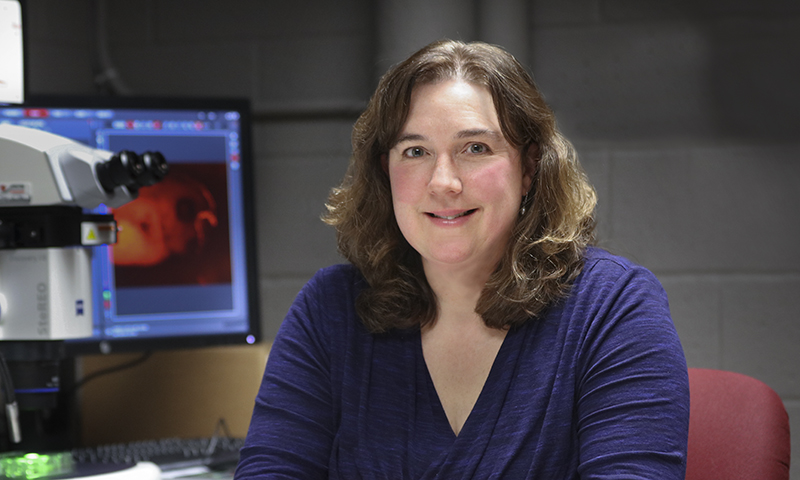
Kristy Kenyon

Kristy L KenyonProfessor of Biology
Joined faculty in 2003
Ph.D., The George Washington University
B.A., Colgate University
Contact Information
Scholarly Interest
Developmental biology: research emphasis on the development of the visual system in vertebrates (Xenopus) and invertebrates (Drosophila)
Molecular and Cell Biology
Neuroscience
Teaching Experience
Brandeis University
The George Washington University
Cold Spring Harbor Laboratory
Research
Postdoctoral Fellow. Harvard Medical School
Massachusetts Eye and Ear Infirmary, Department of Ophthalmology, Boston, MA.
Participant in the NRSA training program "Molecular Basis of Eye Disease?”
During my fellowship, I worked in the laboratory of Dr. Francesca Pignoni. My research projects focused on understanding the genetic control of early eye formation in Drosophila melanogaster.(2000-2003)
Graduate research in the laboratory of Dr. Sally Moody. The George Washington University, Washington, DC. Thesis titled: "Transcriptional Regulators of Xenopus Development: Identifying Novel Factors and Molecular Mechanisms Involved in the Formation of the Eye.”
Courses Taught
Developmental Biology
Molecules and Cells
Publications
Kenyon, K.L., Ranade, S. S., Curtiss, J., Mlodzik, M. and F. Pignoni (2003) “Coordinating proliferation and tissue specification to promote regional identity in the Drosophila head.” Developmental Cell 5:1-20.
Kenyon, K. L., Zaghloul N., and S. A. Moody (2001) “Transcription factors of the anterior neural plate alter cell movements of epidermal progenitors to specify a retinal fate.” Developmental Biology 240(1):77-91.
El-Hodiri, H., Bhatia-Dey, N., Kenyon, K. L., Ault, K., Dirksen, M. and M. Jamrich. (2000) “Fox (forkhead) genes are involved in the dorso-ventral patterning of the Xenopus mesoderm.” International Journal of Developmental Biology 45(1 Spec No):265-71.
Kenyon, K.L, Moody, S.A., and M. Jamrich (1999) “A novel fork head gene mediates early events in Xenopus lens formation.” Development 126, 5107-5116.
Krum, J.M., Kenyon, K.L., and J. M. Rosenstein, J. M. (1997) “Expression of blood-brain barrier characteristics following neuronal loss and astroglial damage after administration of anti-thy-1 immunotoxin.” Experimental Neurology. 146, 33-45.
PROFESSIONAL AFFILIATIONS
Society for Developmental Biology
American Association for the Advancement of Science
The Genetics Society of America
National Science Teachers Association
PERSONAL STATEMENT
I am interested in the remarkable process whereby a single fertilized egg develops into a complex organism. From the point of fertilization onward embryonic cells have to grow, divide, migrate, organize and finally differentiate into a vast number of cell types and tissues. Molecular mechanisms coordinate the activities of embryogenesis to ensure that cells obtain information such as position (e.g., head versus tail/feet), growth (e.g., size versus cell number) and function (e.g., eye versus leg) as they develop. Developmental transitions steer cells into different pathways until a complete repertoire of cell types and tissues is achieved. The control of these events lies directly in the regulation of the genetic information within the developing embryo.
The aim of my research is to investigate the role of transcriptional regulation on the development of the nervous system, with a particular focus on the visual system. Our understanding of the regulation of developmental events has been greatly enhanced by the discovery of genetic factors and the ability to experimentally test their functions during embryogenesis.
Currently, I am working on several research projects that involve studying the genetic control of eye formation in the fruit fly (Drosophila melanogaster). This organism has proven to be invaluable as a model system for studying biological processes that apply to vertebrates (including human!) and invertebrates as well. Using powerful techniques, we can rapidly test gene function in vivo and start to unravel the genetic hierarchy that controls different aspects of development.
In future, I plan to study related mechanisms in vertebrate eye development. The model system that I will be using is the South African clawed frog Xenopus laevis. The rapid development of Xenopus enables one to study many different stages of development such as gastrulation, axis formation or tissue differentiation. Although advanced genetics is not possible using Xenopus, gene expression and function can also be investigated in this system.
Using these two model organisms, my research will also focus on understanding the conservation of gene function between invertebrates and vertebrates in the development of the visual system.
Science is all about asking questions and performing experiments to test your ideas. Being able to participate in research at the undergraduate level gives students a great perspective on what it means to be a “scientist.”
I hope to share my enthusiasm and excitement for studying biology with students in my lectures and at the lab bench. More importantly, I hope to encourage students that a strong basis in scientific knowledge is essential to liberal arts education. A brief look at a daily newspaper reveals the need for an educated public, especially when it comes to the biological and physical world. Science touches almost every aspect of human activity; either as it directly applies to treating and understanding diseases to more global implications such as deciding how to legislate scientific research or tackling environmental issues. Yet, to many, the study of biology and other scientific fields may seem to be a daunting proposition. Convincing students that learning biology can be a rewarding experience that will serve them well regardless of their later professions or interests is my primary goal as an educator.
